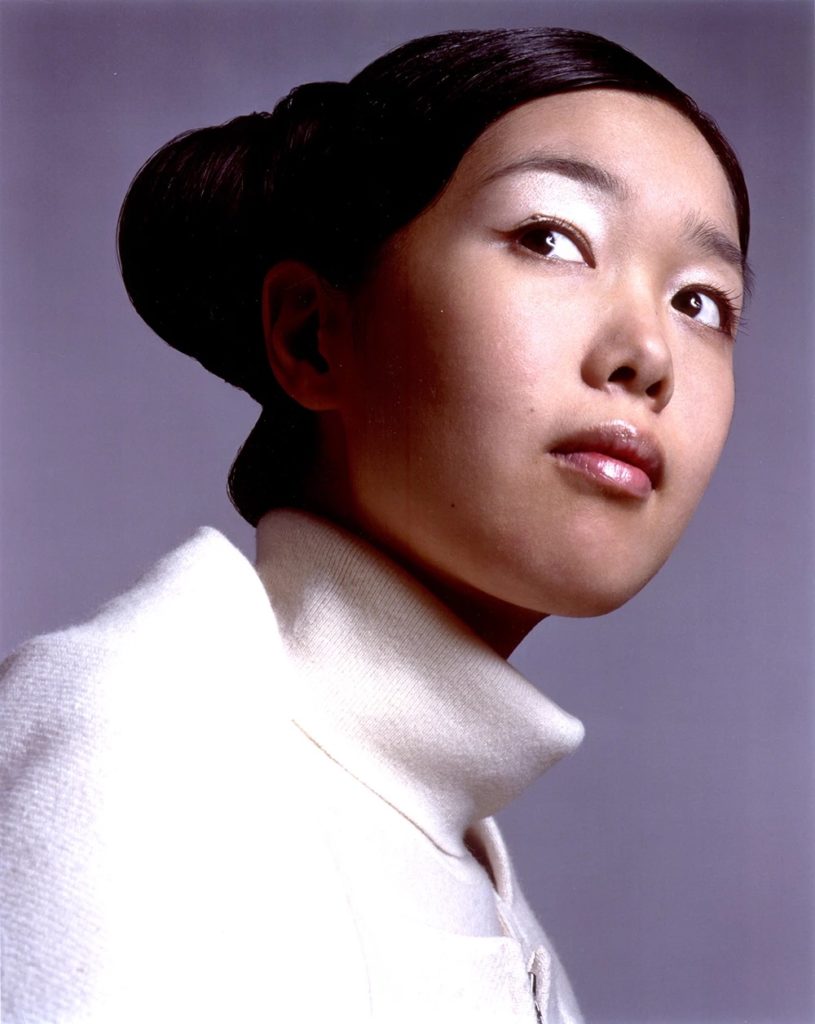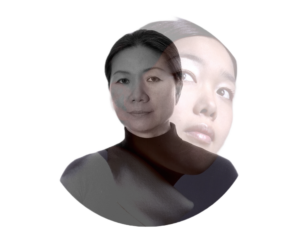Mariko Mori
Be it through vast landscapes dabbled with womb-like clouds or an alien serving tea, Mariko Mori serves us otherworldly art that presents her as a woman claiming subjectivity in the spiritual and material world. “Pure Land” is a scene of postmodern serenity (Fig.1 – See Here). A goddess, played by the artist, floats above the still water of the dead sea. Robots with musical instruments hover around her.  The sky and water share a swath of pinks, oranges, and yellows, only to be separated by a line on the horizon. This image represents the natural element of Earth, one of the four elements of matter, among water, air, and fire, that the artist Mariko Mori visualizes in her series The Esoteric Cosmos, drawing inspiration from technology, nature, and their intersection. However, as the female deity and the series title suggest, neither set of intersections coincide in Esoteric Cosmos: spirituality and feminism. Through a close reading of the complex web of religion-inspired motifs and otherworldly settings Mori created, this chapter examines how she utilized Buddhism and Shintoism, two East Asian religions that many Japanese women piously practice, to comment on the ongoing treatment and exploitative labor of women in Japan. Mori’s concern about the Japanese society at large is shown throughout her entire career; however, this capstone section focuses on the layering of spiritual and feminist aspects intersecting in Esoteric Cosmos. This section begins with a biography of Mori, emphasizing the importance of science and art to her formative years. The next section expands to the feminist movement in Japan and around the world, which is crucial to understanding Mori’s art, the characters she creates, and the personas she takes on. It lays the groundwork for a theoretical discussion of spirituality and contextualizes the late twentieth-century art world within which Mori experimented through staging strategic performance to assert and at times question female subjectivity. My close reading of Mori’s Esoteric Cosmos shows how Mori mingled feminism and spirituality to reshape the traditional identity and role of the Japanese woman. Finally, the spiritual aspects of Mori’s work are proven to be not entirely traditional, as she did not simply recreate Buddhist images in her work. Although not in the strictest reading of Esoteric Buddhism, Mori combined traditional and novel aspects of spirituality for the staging and performance of Esoteric Cosmos.
The sky and water share a swath of pinks, oranges, and yellows, only to be separated by a line on the horizon. This image represents the natural element of Earth, one of the four elements of matter, among water, air, and fire, that the artist Mariko Mori visualizes in her series The Esoteric Cosmos, drawing inspiration from technology, nature, and their intersection. However, as the female deity and the series title suggest, neither set of intersections coincide in Esoteric Cosmos: spirituality and feminism. Through a close reading of the complex web of religion-inspired motifs and otherworldly settings Mori created, this chapter examines how she utilized Buddhism and Shintoism, two East Asian religions that many Japanese women piously practice, to comment on the ongoing treatment and exploitative labor of women in Japan. Mori’s concern about the Japanese society at large is shown throughout her entire career; however, this capstone section focuses on the layering of spiritual and feminist aspects intersecting in Esoteric Cosmos. This section begins with a biography of Mori, emphasizing the importance of science and art to her formative years. The next section expands to the feminist movement in Japan and around the world, which is crucial to understanding Mori’s art, the characters she creates, and the personas she takes on. It lays the groundwork for a theoretical discussion of spirituality and contextualizes the late twentieth-century art world within which Mori experimented through staging strategic performance to assert and at times question female subjectivity. My close reading of Mori’s Esoteric Cosmos shows how Mori mingled feminism and spirituality to reshape the traditional identity and role of the Japanese woman. Finally, the spiritual aspects of Mori’s work are proven to be not entirely traditional, as she did not simply recreate Buddhist images in her work. Although not in the strictest reading of Esoteric Buddhism, Mori combined traditional and novel aspects of spirituality for the staging and performance of Esoteric Cosmos.
New Ideas: Growing Up
Mariko Mori was born in 1967 in Tokyo, Japan. Mori was the daughter of a scholar in Northern Renaissance art, and an inventor and “incubator of new ideas,” according to the artist herself.[8] At only eighteen months old in 1968, Mori moved to Philadelphia because her father, Kei Mori, was a visiting scholar at Wharton School of the University of Pennsylvania. During their two-year stay in the suburbs of Philadelphia, Mori’s mother, Yoko Arisawa went to graduate school at Bryn Mawr to further her studies in North Renaissance art. By “enjoying the precious experience of creative international interaction with children who came from various countries,” Mori had an early exposure to the global world.[9] Her parents’ professions and this experience undoubtedly played a role in her creative start and artistic interests. She returned to Japan in 1970 with her parents and her sister, Asuka Mori, was born three years later.[10]
Mori started her schooling in the creative field at Tokyo’s Bunka Fashion College (Bunka Fukusō Gakuin). She also worked as a model during her time at fashion school. Her study of fashion and her career in modeling, as you can see later in this thesis, play a significant role, starting with her early works and throughout her Esoteric Cosmos. Her interest in fashion and costumes are evident in how she dresses her characters and prompts her first exploration of the connection between body, clothing, and identity. In 1988, Mori went to London to study art at the Byam Shaw School of Art and later the Chelsea College of Art and Design. Mori discovered a whole world of art that she had been missing in Japan. The London art world, she found, was the best outlet for self-expression. After studying painting and fashion in the UK, Mori dove into performance-based photographs.[11] According to scholar Allison Holland, it was the European influence and the political, economic, and social climate of the cosmopolitan city of London that challenged Mori’s understanding of “self and nation, ethnicity and gender.”[12] She would have been aware of the political instability and racial tension in London throughout the 80s and the homogenous “Britishness” that was being challenged.[13] The subcultures of fashion and art that Mori encountered during her time in London allowed her to find new forms of creative expression. Having modeled and studied fashion in Tokyo previously, her time in London exploring the subcultures of art, fashion, and music allowed Mori to create and use transnational design tropes. Additionally, her time at Chelsea produced an understanding of identity based on the mass media constructs of model, celebrity, and artist. Given Mori’s background, it is clear how the lines between self, nation, ethnicity, and gender become blurred, but her identity as a Japanese woman was never lost.[14]
In 1992, Mori moved to New York City, where she keeps a studio to this day. Mori enrolled in the prestigious yearlong Independent Study Program at the Whitney Museum of American Art. The cultural milieu in New York was more boundless, somewhere Mori could feel free of her Japanese societal norms. While she familiarized herself with critical theory and diverse artistic practices in the ISP, New York positioned her at the center of the global art market and offered her the opportunity to launch a career, such as establishing representation with prominent galleries like Jeffrey Deitch in New York and Emmanuel Perrotin in Paris.
Mori primarily works in performance video, digitized and commercially produced photos, 3D video installations, and plays with “pseudo-scientific objects,” such as an invention of her fathers called the Himawari (Japanese for “sunflower”) (Fig. 2). This solar transmitting device created by her father was just one example of the help she received from the international team of engineers with which she worked closely.[15] She keeps studios in both New York and Tokyo, thus working in more than one significant global art community.[16]

